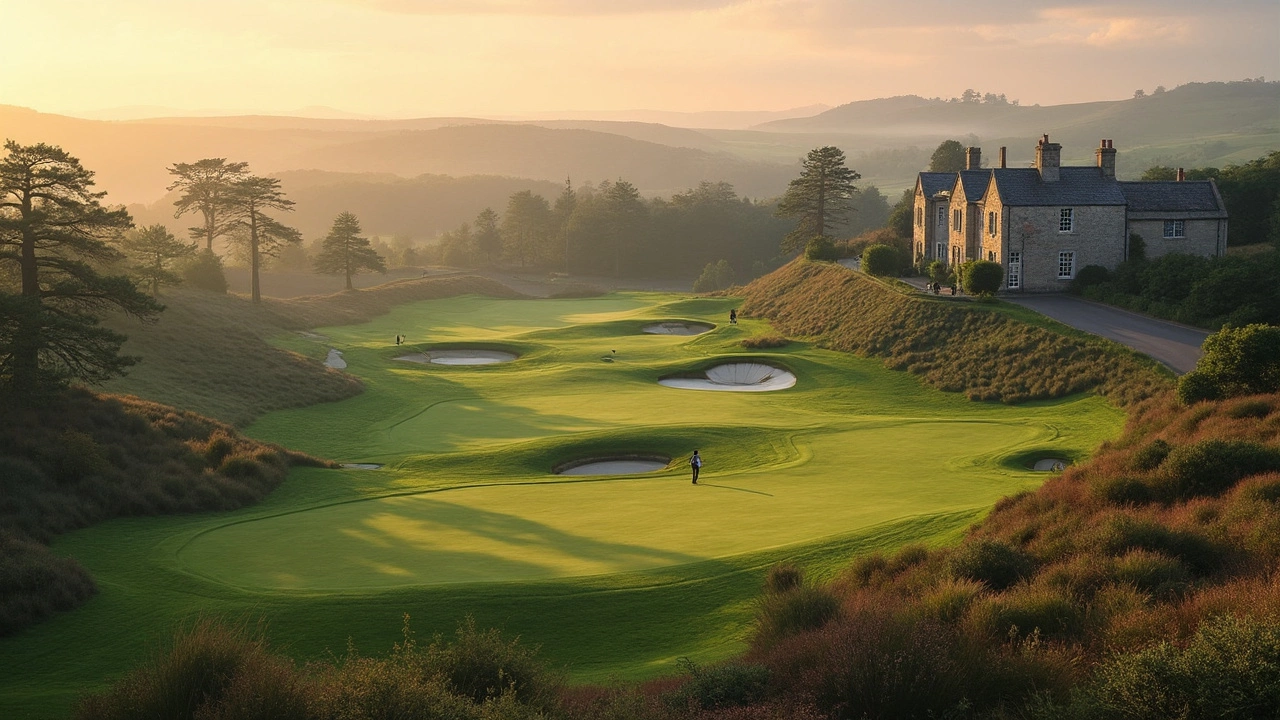
Golf April 23, 2025
What Is the Golf Field Called? A Real-World Guide to Golf Course Lingo
You hear people call it a golf field all the time, but that’s not what the pros (or anyone into golf) say. The actual term is “golf course.” If you walk up to a group of golfers and mention playing on the golf field, you’ll get a few sideways looks. It sounds small, but using the right word shows you know the basics.
A golf course is where all the action happens—from teeing off right through to putting on the green. It’s not just some big open field; it’s packed with features that each have their own names and purposes. And if you’re just getting into golf, or maybe you want to impress at your next company outing, using “golf course” instead of “field” is the first step to sounding like you belong.
- So, What Do You Call a Golf Field?
- Anatomy of a Golf Course
- Why 'Golf Course' and Not 'Field'?
- Common Terms Every Golfer Should Know
- Golf Course Fun Facts You Probably Didn't Know
- Quick Tips for Newcomers
So, What Do You Call a Golf Field?
Here’s the deal—“golf field” isn’t the right name in the golf world. The correct term is golf course. So if you want to talk like you belong, always say 'course,' not 'field.' Kind of like how you don’t say 'football field' when you’re in England—it’s the pitch. Same idea, different sport.
The word golf course has been around for centuries. As far back as the 15th century, when people first started smacking balls around the dunes in Scotland, they called it a 'course.' This stuck, and with good reason. It’s specifically made for playing golf, designed with tees, fairways, bunkers, greens, and hazards—stuff you just don’t get in an ordinary field.
Maybe you've heard people use “golf links” too. That term comes from old Scottish courses built on sandy coastal land called 'linksland.' It mostly refers to a special type of course, not every golf course out there. So, if you’re playing at your local city layout, just stick with ‘course.’
Here’s a side-by-side so you see what I mean:
| Term | Where It's Used | Meaning |
|---|---|---|
| Golf Course | Worldwide | The proper name for a place you play golf. |
| Golf Field | Mostly casual or new players | Not a correct term, rarely used by golfers. |
| Golf Links | UK and some US courses | A special type of coastal, sandy golf course. |
Sticking with golf course is the safe bet every single time. You’ll sound like you know your stuff, and you won’t risk getting called out by golf regulars.
Anatomy of a Golf Course
A golf course isn’t just a big patch of grass. It’s a carefully designed mix of different areas, each with its own job. Knowing what’s what helps you play smarter and talk golf without sounding lost. Let’s break it down.
The main parts of any golf course are:
- Tee box: This is where every hole starts. The ground here is flat and short so you get a clean shot off the tee. Most holes have a few tee boxes for different skill levels and ages.
- Fairway: The fairway is the short-cut grass you’re aiming for after you leave the tee box. It gives you the best chance for a good next shot. You want your ball in the fairway, not on rough.
- Rough: This is the longer, thicker grass on either side of the fairway. End up here, and your next shot gets tougher. Some golf courses crank up the rough to make things even more challenging.
- Bunkers: These are the sandy traps lurking near the fairway, green, or both. Pros call them “hazards” for a reason. Getting out clean is a big part of a decent round.
- Green: This is the super-smooth, ultra-short grass where the hole and flagstick live. Putting is all about reading the slopes and speed here. Most greens are trickier than they look.
- Hazards: Besides bunkers, hazards can also mean water—like ponds or streams. Hitting in here usually means penalty strokes.
Here’s a quick comparison of their usual sizes and purpose:
| Area | Approximate Size | Main Purpose |
|---|---|---|
| Tee Box | 50-100 sq yards | Starting point for each hole |
| Fairway | 30-50 yards wide | Best area for next shot |
| Green | 3,000-6,000 sq feet | Putting to finish the hole |
| Bunker | Varies, up to 1,000 sq feet or more | Obstacle; adds challenge |
| Water Hazard | Varies, can run along several holes | Obstacle; risk-reward shots |
Depending on the club, a full-sized golf course has 18 holes, but some smaller ones have just 9. Each hole has a different length and layout, forcing you to use a mix of shots and clubs.
Course layout is also strategic. Designers throw different challenges at you—doglegs, uphill shots, tricky greens—so no two holes feel the same. Next time you’re on a golf course, take a minute to spot how much planning went into every corner.
Why 'Golf Course' and Not 'Field'?
Let’s clear this up: people call it a golf course instead of a field for a good reason. Unlike a soccer field or baseball field, a golf course isn’t just one flat, grassy space. It’s loaded with unique features for every hole—think tees, fairways, bunkers, greens, rough, and water hazards. Each part affects how the game plays out.
In the golf world, the word “field” just doesn’t fit. A field sounds basic and flat. A course is purposely designed with twists and challenges for every shot. As the United States Golf Association puts it:
"A golf course is a ground developed for playing the game of golf, usually consisting of a series of holes and features to test a player's skill." — USGA
Here’s a simple way to see the difference—almost every sport has its field, but golf stands out. Golfers never say, "Let's meet at the field." It's always "Let's hit the golf course." Using the right term helps you blend in and be taken more seriously when talking to other players or staff.
If you want to get technical, each golf course usually has 18 holes, and the layout can stretch over 100 acres. That’s a lot more complicated than a standard field. Plus, designers spend years planning out the hazards, slopes, and landscapes to make every hole unique.
| Sport | Playing Area Name |
|---|---|
| Soccer | Field |
| Baseball | Field |
| Football | Field |
| Golf | Course |
Bottom line: if you want to sound like you actually play or follow golf, start saying golf course. It shows you get what makes golf special compared to other sports.

Common Terms Every Golfer Should Know
If you want to sound like you know your way around a golf course, getting the lingo down helps a ton. Here are some words you’ll hear all the time when you’re out on the fairway or just chatting with other golf fans:
- Fairway – The neat strip of short grass between the tee and the green. This is where you want your ball to land after you hit your drive. Playing from the fairway is way easier than hacking out of the rough.
- Green – The smooth, manicured area with the hole. This is where you use your putter. The grass here is super short and rolls fast.
- Rough – The taller, thicker grass alongside the fairway. It’s tougher to play from here, so most golfers try to avoid it.
- Bunker (or sand trap) – Those sandy pits next to the fairway or the green. Bunkers can mess up your score if you aren’t careful.
- Tee box – The starting area for each hole. It’s the only place on the golf course where you get to put your ball on a tee.
- Hazard – These can be water (like ponds or streams) or the aforementioned bunkers. Hazards make things more interesting—and sometimes nerve wracking.
- Par – The expected number of strokes to finish a hole. Every hole on a course has a “par” value. If you do it in that number, great. Less than par? Even better. More than par? Well, you’ll want to work on that.
Here’s a quick reference table you can save or screenshot for your next round:
| Term | What it means |
|---|---|
| Fairway | Short grass area between tee and green |
| Green | Area with the hole and shortest grass, for putting |
| Rough | Tall grass, harder to hit from |
| Bunker | Sand pit hazard, tough to play from |
| Tee Box | Start area for each hole |
| Hazard | Bunkers or water obstacles |
| Par | Standard number of strokes for the hole |
When you toss around words like these, you’ll sound like you’ve actually played—or at least watched enough golf to keep up. Next time you step onto a golf course, try using these terms and see how quickly you fit right in.
Golf Course Fun Facts You Probably Didn't Know
There’s a lot about a golf course that most people have no clue about, even if they play regularly. For starters, the average 18-hole golf course isn’t a set size. Some are as little as 5,000 yards, while championship courses can stretch over 7,000 yards.
Ever heard the name “Augusta National”? That’s one of the most famous golf courses in the world. It hosts the Masters Tournament every year and is so private, even pro golfers need an invite to play there.
Here’s an interesting tidbit—no two golf courses are built the same. Each one is designed with its own layout, obstacles, and mix of holes. That’s why you’ll hear die-hard golfers talking about playing at as many different courses as they can. They want a new challenge every time.
Want some numbers? Check this out:
| Country | Number of Golf Courses |
|---|---|
| United States | Over 16,000 |
| Japan | About 3,000 |
| UK | Roughly 2,500 |
| Australia | 1,500+ |
Here are a few more bite-size facts:
- The oldest golf course that’s still running? That’s the Old Links at Musselburgh, Scotland, where folks have been playing since at least 1672.
- Most golf courses have either 9 or 18 holes—12-hole courses are rare, but they do exist.
- The word “green” doesn’t just mean the grass. In golf terms, “the green” is the short-cut area around the hole where you putt. That patch gets more attention than most people give their own lawns.
So, the next time you’re chatting about a golf course with friends or co-workers, you’ll have a couple of fun facts in your back pocket.
Quick Tips for Newcomers
Just starting out on the golf course? There’s a lot to take in, but you don’t have to learn everything at once. Here are some practical tips that’ll help you enjoy your round and avoid looking out of place.
- Always call it a golf course—not a golf field.
- If someone says "tee box,” "fairway,” or "green,” they’re talking about different parts of the golf course. The tee box is where you start each hole, the fairway is the short grass you aim for, and the green is where the flag and hole are.
- Don’t worry if you don’t hit straight. Even pros mess up. Just focus on basic form and enjoy being outside.
- Keep up the pace. You don’t have to run, but always be ready when it’s your turn. Slow play is one of the biggest gripes on any golf course.
- Dress the part. Every golf course has its own dress code, but tucked-in shirts and golf shoes are usually expected. No jeans or cargo shorts at most places.
- Show up early. This gives you time to warm up and learn where the lockers, restrooms, and practice areas are.
- If you’re not sure about rules or etiquette, just ask. Most regulars love giving advice to newcomers. In fact, a USGA survey found that 68% of golfers enjoy helping beginners on the course.
Avoid these rookie mistakes:
- Standing too close behind someone when they're swinging – it’s distracting and risky.
- Walking or driving your cart on the green – a big no-no.
- Taking forever to look for lost balls. By the rules, you’ve got three minutes, then drop a new one and move on.
Most important: have fun and don’t stress over bad shots. The golf course is a place to learn and improve, but it’s also about enjoying good company and fresh air. Keep showing up, and you’ll feel like a regular before you know it.




